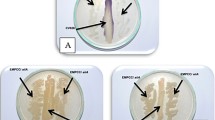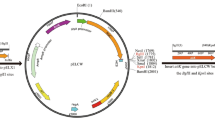Abstract
To study the role of Quorum Sensing (QS) regulation in the control of the cellular processes of Burkholderia cenocepacia 370, plasmid pME6863 was transferred into its cells. The plasmid contains a heterologous gene encoding AiiA N-acyl-homoserine lactonase, which degrades the signaling molecules of the QS system of N-acyl-homoserine lactones (AHL). An absence or reduction of AHL in the culture was revealed with the biosensors Chromobacterium violaceum CV026 and Agrobacterium tumefaciens NT1/pZLR4, respectively. The presence of the aiiA gene, which was cloned from Bacillus sp. A24 in the cells of B. cenocepacia 370, resulted in a lack of hemolytic activity, reduced the extracellular proteolytic activity and decreased the cells’ ability to swarming migration on the surface of the agar medium. The introduction of the aiiA gene did not affect lipase activity, fatty acids synthesis, HCN synthesis, or biofilm formation. Hydrogen peroxide was shown to stimulate biofilm formation by B. cenocepacia 370 in concentrations that inhibited or weakly suppressed bacterial growth. The introduction of the aiiA gene into the cells did not eliminate this effect but it did reduce it.
Similar content being viewed by others
References
Coenye, T. and Vandamne, P., Diversity and significance of Burkholderia species occupying diverse ecological niches, Environ. Microbiol., 2003, vol. 5, pp. 719–729.
Vial, L., Chapalain, A., Groleau, M. C., and Déziel, E., The various lifestyles of the Burkholderia cepacia complex species: a tribute to adaptation, Environ. Microbiol., 2011, vol. 13, pp. 1–12.
Waters, C. and Bassler, B., Quorum Sensing: cell-tocell communication in bacteria, Annu. Rev. Cell Dev. Biol., 2005, vol. 21, pp. 319–346.
Khmel, I. A. and Metlitskaya, A. Z., Quorum sensing regulation of gene expression: a promising target for drugs against bacterial pathogenicity, Mol. Biol. (Moscow), 2006, vol. 40, no. 2, pp. 169–182.
Huber, B., Riedel, K., Hentzer, M., et al., The cep quorum-sensing system of Burkholderia cepacia H111 controls biofilm formation and swarming motility, Microbiology, 2001, vol. 147, pp. 2517–2528.
Malott, R., Baldwin, A., Mahenthiralingam, E., and Sokol, P., Characterization of the cciIR quorum-sensing system in Burkholderia cenocepacia, Infect. Immunol., 2005, vol. 73, pp. 4982–4992.
Eberl, L., Quorum sensing in the genus Burkholderia, Int. J. Med. Microbiol., 2006, vol. 296, pp. 103–110.
Sokol, P. A., Malott, R. J., Riedel, K., and Eberl, L., Communication systems in the genus Burkholderia: global regulators and targets for novel antipathogenic drugs, Future Microbiol., 2007, vol. 2, pp. 555–563.
O’Grady, E. P., Viteri, D. F., Malott, R. J., and Sokol, P. A., Reciprocal regulation by the CepIR and CciIR quorum sensing systems in Burkholderia cenocepacia, BMC Genomics, 2009. doi 10. 1186/1471-2164-10-441
Loutet, S. A. and Valvano, M. A., A decade of Burkholderia cenocepacia virulence determinant research, Infect. Immunol., 2010, vol. 78, pp. 4088–4100.
Suppiger, A., Schmid, N., Aguilar, C., et al., Two quorum sensing systems control biofilm formation and virulence in members of the Burkholderia cepacia complex, Virulence, 2013, vol. 4, pp. 400–409.
Deng, Y., Boon, C., Eberl, L., and Zhang, L. -H., Differential modulation of Burkholderia cenocepacia virulence and energy metabolism by the Quorum-Sensing signal BDSF and its synthase, J. Bacteriol., 2009, vol. 191, pp. 7270–7278.
Diggle, S., Winzer, K., Lazdunski, A., et al., Advancing the quorum in Pseudomonas aeruginosa, MvaT and the regulation of N-acylhomoserine lactone production and virulence gene expression, J. Bacteriol., 2002, vol. 184, pp. 2576–2586.
Reimmann, C., Ginet, N., Michel, L., et al., Genetically programmed autoinducer destruction reduces virulence gene expression and swarming motility in Pseudomonas aeruginosa PAO1, Microbiology, 2002, vol. 148, pp. 923–932.
Veselova, M. A., Lipasova, V. A., Zaitseva, Yu. V., et al., Mutants of Burkholderia cenocepacia with a change in synthesis of N-acyl-homoserine lactones—signal molecules of quorum sensing regulation, Russ. J. Genet., 2012, vol. 48, no. 5, pp. 513–521.
Miller, J., Experiments in Molecular Genetics, Cold Spring Harbor: Cold Spring Harbor Laboratory, 1972.
McClean, K. H., Winson, M. K., Fish, L., et al., Quorum sensing in Chromobacterium violaceum: exploitation of violacein production and inhibition for the detection of N-acylhomoserine lactones, Microbiology, 1997, vol. 143, pp. 3703–3711.
Shaw, P. D., Ping, G., Daly, S. L., et al., Detecting and characterizing N-acyl-homoserine lactone signal molecules by thin-layer chromatography, Proc. Natl. Acad. Sci. U. S. A., 1997, vol. 94, pp. 6036–6041.
Lonon, M., Woods, D., and Straus, D., Production of lipase by clinical isolates of Pseudomonas cepacia, J. Clin. Microbiol., 1988, vol. 26, pp. 979–984.
Déziel, E., Comeau, Y., and Villemur, R., Initiation of biofilm formation by Pseudomonas aeruginosa 57RP correlates with emergence of hyperpiliated and highly adherent phenotypic variants deficient in swimming, swarming, and twitching motilities, J. Bacteriol., 2001, vol. 183, pp. 1195–1204.
Tsaplina, I. A., Osipov, G. A., Bogdanova, T. I., et al., The fatty acid composition of lipids of thermoacidophilic bacteria of the genus Sulfobacillus, Mikrobiologiya, 1994, vol. 63, no. 5, pp. 390–401.
Davies, D. G., Parsek, M. R., and Pearson, J. P., et al., The involvement of cell-to-cell signals in the development of a bacterial biofilm, Science, 1998, vol. 280, pp. 295–298.
Plyuta, V. A., Andreenko, Yu. V., Kuznetsov, A. E., and Khmel, I. A., Formation of Pseudomonas aeruginosa PAO1 biofilms in the presence of hydrogen peroxide: the effect of the aiiA gene, Mol. Genet., Microbiol. Virusol., 2013, no. 4, pp. 141–146.
Wopperer, J., Cardona, S. T., Huber, B., et al., Quorumquenching approach to investigate the conservation of quorum-sensing-regulated functions within the Burkholderia cepacia complex, Appl. Environ. Microbiol., 2006, vol. 72, pp. 1579–1587.
Ulrich, R. L., Quorum quenching: enzymatic disruption of N-acyl-homoserine lactone-mediated bacterial communication in Burkholderia thailandensis, Appl. Environ. Microbiol., 2004, vol. 70, pp. 6173–6180.
O’Toole, G. A. and Kolter, R., Flagellar and twitching motility are necessary for Pseudomonas aeruginosa biofilm development, Mol. Microbiol., 1998, vol. 30, pp. 295–304.
De Kievit, T. R., Quorum sensing in Pseudomonas aeruginosa biofilms, Environ. Microbiol., 2009, vol. 11, pp. 279–288.
Pessi, G. and Haas, D., Transcriptional control of the hydrogen cyanide biosynthetic genes hcnABC by the anaerobic regulator ANR and the quorum-sensing regulators LasR and RhlR in Pseudomonas aeruginosa, J. Bacteriol., 2000, vol. 182, pp. 6940–6949.
Wei, H. L. and Zhang, L. Q., Quorum-sensing system influences root colonization and biological control ability in Pseudomonas fluorescens 2P24, Antonie van Leeuwenhoek, 2006, vol. 89, pp. 267–280.
Hoffman, L. R., D’Argenio, D. A., MacCoss, M. J., et al., Aminoglycoside antibiotics induce biofilm formation, Nature, 2005, vol. 436, pp. 1171–1175.
Linares, J. F., Gustaffson, I., Baquero, F., and Martinez, J. L., Antibiotics as intermicrobial signaling agents instead of weapons, Proc. Natl. Acad. Sci. U. S. A., 2006, vol. 103, pp. 19484–19489.
Zaitseva, J., Granik, V., Belik, A., et al., Effect of nitrofurans and NOgenerators on biofilm formation by Pseudomonas aeruginosa PAO1 and Burkholderia cenocepacia 370, Res. Microbiol., 2009, vol. 160, pp. 353–357.
Plyuta, V. A., Lipasova, V. A., Kuznetsov, A. E., and Khmel’, I. A., Effect of salicylic, indolil-3-acetic, gibberellic, and abscisic acids on biofilm formation by Agrobacterium tumefaciens C58 and Pseudomonas aeruginosa PAO1, Biotekhnologia, 2012, no. 3, pp. 53–58.
Plyuta, V. A., Zaitseva, J., Lobakova, E., et al., Effect of plant phenolic compounds on biofilm formation by Pseudomonas aeruginosa, APMIS, 2013, vol. 121, pp. 1073–1081.
Busse, H. J., Denner, E. B., and Lubitz, W., Classification and identification of bacteria: current approaches to an old problem: overview of methods used in bacterial systematics, J. Biotechnol., 1996, vol. 47, pp. 3–38.
Author information
Authors and Affiliations
Corresponding author
Additional information
Original Russian Text © V.A. Plyuta, V.A. Lipasova, O.A. Koksharova, M.A. Veselova, A.E. Kuznetsov, I.A. Khmel, 2015, published in Genetika, 2015, Vol. 51, No. 8, pp. 864–872.
Rights and permissions
About this article
Cite this article
Plyuta, V.A., Lipasova, V.A., Koksharova, O.A. et al. The effect of introduction of the Heterologous gene encoding the N-acyl-homoserine lactonase (aiiA) on the properties of Burkholderia cenocepacia 370. Russ J Genet 51, 737–744 (2015). https://doi.org/10.1134/S1022795415080062
Received:
Accepted:
Published:
Issue Date:
DOI: https://doi.org/10.1134/S1022795415080062




